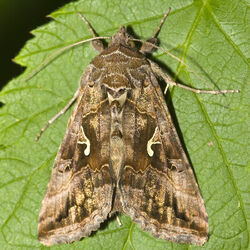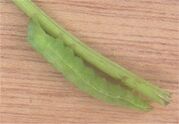| Silver Y moth | |
|---|---|
 |
|
| A. gamma on a leaf showing the 'Y'-shaped markings on its wings (beige) | |
| Scientific Classification | |
| Kingdom: | Animalia |
| Phylum: | Arthropoda |
| Class: | Insecta |
| Order: | Lepidoptera |
| Family: | Noctuidae |
| Genus: | Autographa |
| Species: | Autographa gamma |
The Silver Y (Autographa gamma) is a migratory moth of the family Noctuidae which is named for the silvery Y-shaped mark on each of its forewings. Silver Y caterpillars can damage various herbs including basil, parsley and brassicas. They are green with dark stripes along the back and a narrow yellow line down the side. These caterpillars have only three pairs of prolegs, instead of the usual five pairs.[1]
Symptoms[]
Caterpillar damage can usually be distinguished from slug or snail damage by the presence of caterpillar droppings (frass, often barrel-shaped) on the leaves and the lack of slime trails. Young caterpillars can produce 'windows' in the leaf, where only the underside is removed, leaving the upper surface intact.[1]
Treatment[]
Biological control[]
Bacillus thuringiensis var. kurstaki[]
B. thuringiensis var. kurstaki, known 'Bt' or Dipel DF, is a bacterial biopesticide which is specific to caterpillars. Bt is applied as a high volume spray and has a SOLA for use on protected and outdoor herbs. It is most effective against young caterpillars. Optimal control relies on good coverage of both sides of the leaves, as the caterpillars need to eat treated foliage to take in the bacteria. Dipel DF should be sprayed onto dry foliage and plants should not be watered overhead within 6 hours of treatment. Once ingested Bt quickly stops the caterpillars from feeding, but death can take 1-3 days. Dead caterpillars shrivel up and can sometimes be seen hanging from the foliage.[1]
Trichogramma brassicae[]
T. brassicae is a minute wasp that parasitises moth eggs, supplied as black parasitised eggs on cards. Adult wasps emerge from the eggs and search to find suitable moth eggs that have been laid on the plants. The parasitised eggs turn black and develop into more parasites instead of caterpillars.[1]
Chemical[]
Tracer (spinosad)[]
Tracer has a SOLA for use on protected herbs and is effective against caterpillars. The product is safe to many biological control agents but is harmful to parasitic wasps e.g. those used for leaf miner or whitefly control, for up to 2 weeks after application. Although there should be no resistance problems with caterpillars, over-use of Tracer could lead to thrips' tolerance of the pesticide. Thus it is very important to follow the Specific Resistance Management Guidelines given on the SOLA.[1]
Spruzit (pyrethrins plus oil)[]
Spruzit is approved for use on any protected edible crop and is effective against caterpillars. The product is harmful to many biological control agents but has only limited persistence, thus it can be used with care within IPM programmes. Spruzit has been known to cause leaf damage to curly parsley. The product should be tested on a few plants first for any herb species, before using on a large scale, particularly if more than one application is made.[1]
Prevention[]
Cultural control[]
Maintain strict weed control in and around glasshouses and tunnels, including in empty structures in between crops.[1]
Dispose of unwanted infested plants and any plant debris promptly and carefully.[1]
Pheromone traps are available for silver Y moth. They will trap male moths and are intended as a monitoring system - use for early warning of first moth activity, to help time control measures. The traps themselves are not intended as a control measure; too few moths will be caught to affect the population size.[1]
Examples[]
References[]
| Brassica troubles |
|
|---|---|
| Broccoli · Brussels sprout · Cabbage · Cauliflower · Kale · Kohl rabi · Radish · Swede · Turnip | |
| Adverse conditions | Blown sprouts · Bolting · Boron deficiency · Button cauliflower · Calcium deficiency · Heartless cabbage · Magnesium deficiency · Manganese deficiency · Molybdenum deficiency · Nitrogen deficiency · Split heart |
| Diseases | Anthracnose · Bacterial soft rot · Black leaf spot · Black rot · Brassica dark leaf spot · Club root · Downey mildew · Grey leaf spot (Brassica) · Turnip mosaic virus · Sclerotinia rot · White leaf spot · White leaf spot (Brassica) · White rust · Wire stem |
| Pests | Aphid · Cabbage aphid · Cabbage Moth · Cabbage root fly · Cabbage Whitefly · Cutworm · Diamondback moth · Flea beetle · Large White · Pigeon · Silver Y moth · Slug · Small White · Swede midge · Thrips |
| Mint troubles |
|
|---|---|
| Basil · Lavender · Lemon balm · Marjoram · Mint · Oregano · Rosemary · Sage · Savory · Thyme | |
| Adverse conditions | Bolting |
| Diseases | Downy mildew · Fusarium wilt · Grey mould · Powdery mildew · Rhizoctonia solani · Rust · Septoria leaf spot of lemon balm · Verticillium wilt |
| Pests | Aphid · Cabbage whitefly · Capsid bug · Celery fly · Leaf miner · Leafhopper · Red spider mite · Shore fly · Silver Y moth · Slug |
![Dill Silver y moth Autographa gamma.jpg (35 KB) Larvae on [[dill]](https://static.wikia.nocookie.net/gardener/images/b/bc/Dill_Silver_y_moth_Autographa_gamma.jpg/revision/latest/scale-to-width-down/165?cb=20100919170140)
